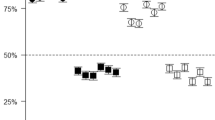Abstract
Proportion problems were given to pupils in grades 3, 4, and 5. The number structure of the problems was kept at an elementary level and the contexts were varied. The success rates were high, which shows that young children have some understanding of the concept of proportion. Elementary strategies based on addition were often used. Familiarity with the use of ratios in the context, the presence of a mixture, and the use of manipulatives were context variables that influenced performance. The abilities required to solve proportion problems in various contexts were essentially independent from each other. The cognitive characteristics that predict success were found to be different from those that predict use of multiplicative strategies.
Similar content being viewed by others
References
Case R.: 1974, ‘Structures and strictures: Some functional limitations on the course of cognitive growth’, Cognitive Psychology 6, 544–573.
deAvila E. A., Havassy B., and Pascual-Leone J.: 1976, Mexican-American School Children: A Neo-Piagetian Analysis, Georgetown University Press, Washington, D.C.
Fischbein E., Deri M., Sainati Nello M., Sciolis Marino M.: 1985, ‘The role of implicit models in solving verbal problems in multiplication and division’, Journal for Research in Mathematics Education 16, 3–17.
Furman, I.: 1981, The Development of Problem-Solving Strategies: A Neo-Piagetian Analysis of Children's Performance in a Balance Task, Unpublished doctoral dissertation, University of California, Berkeley.
Inhelder B. and Piaget J.: 1958, The Growth of Logical Thinking from Childhood to Adolescence, Basic Books, New York.
Karplus R., Pulos S., and Stage E. K.: 1983, ‘Proportional reasoning of early adolescents’, in R.Lesh, and M.Landau (eds.), Acquisition of Mathematics Concepts and Processes, Academic Press, New York.
Karplus, R., Tourniaire, F., Pulos, S., and Stage, E. K.: 1982, ‘Reasoning with unknowns in grades 4, 6 and 8’, Proceedings of the Fourth Annual Meeting of the North American Chapter of the Group for the Psychology of Mathematics Education, 120–125.
Lawson A. E. and Wollman W. T.: 1977, ‘Cognitive level, cognitive style, and value judgment’, Science Education 61, 397–407.
Pulos S. and Linn M. C.: 1979, The Find A Shape Puzzle (FASP): A Group Measure of Cognitive Restructuring, Unpublished Research Report, Adolescent Reasoning Project, Lawrence Hall of Science, University of California, Berkeley.
deRibaupierre A. and Pascual-Leone J.: 1979, ‘Formal operations and M-power: A neo-Piagetian investigation’, in D.Kuhn (ed.), Intellectual Development Beyond Childhood, Jossey-Bass, San Francisco.
Ricco G.: 1982, ‘Les premières acquisitions de la potion de fonction linéaire chez l'enfant de 7 à 11 ans”, Educational Studies in Mathematics 13, 289–327.
Rupley, W. H.: 1981, The Effects of Numerical Characteristics on the Difficulty of Proportion Problems, Unpublished doctoral dissertation, University of California, Berkeley.
Tourniaire F. and Pulos S.: 1985, ‘Proportional reasoning: A review of the literature’, Educational Studies in Mathematics 16, 181–204.
Author information
Authors and Affiliations
Additional information
This article is based on research reported in a doctoral dissertation submitted to the University of California, Berkeley, in partial fulfillment of requirements for the Ph.D. degree. A preliminary version of the article was presented at the Research Council for Diagnostic and Prescriptive Mathematics, San Francisco, April 1984.
Rights and permissions
About this article
Cite this article
Tourniaire, F. Proportions in elementary school. Educ Stud Math 17, 401–412 (1986). https://doi.org/10.1007/BF00311327
Issue Date:
DOI: https://doi.org/10.1007/BF00311327




